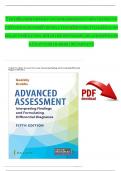TEST6BANK6FOR6ADVANCED6ASSESSMENT:6INTERPRETIN
G6FINDINGS6AND6FORMULATING6DIFFERENTIAL6DIAGNO
SES,65TH6EDITION,6MARY6JO6GOOLSBY,6LAURIE6GRUBB
S6CHAPTER616-6226|6COMPLETE
,Chapter61.6Assessment6and6Clinical6Decision-Making:6Overview
Multiple6Choice
Identify6the6choice6that6best6completes6the6statement6or6answers6the6question.
6 1. Which6type6of6clinical6decision-making6is6most6reliable?
A. Intuitive
B. Analytical
C. Experiential
D. Augenblick
6 2. Which6of6the6following6is6false?6To6obtain6adequate6history,6health-care6providers6must6be:
A. Methodical6and6systematic
B. Attentive6to6the6patient’s6verbal6and6nonverbal6language
C. Able6to6accurately6interpret6the6patient’s6responses
D. Adept6at6reading6into6the6patient’s6statements
6 3. Essential6parts6of6a6health6history6include6all6of6the6following6except:
A. Chief6complaint
B. History6of6the6present6illness
C. Current6vital6signs
D. All6of6the6above6are6essential6history6components
6 4. Which6of6the6following6is6false?6While6performing6the6physical6examination,6the6examiner
6must6be6able6to:
A. Differentiate6between6normal6and6abnormal6findings
B. Recall6knowledge6of6a6range6of6conditions6and6their6associated6signs6and6symptoms
C. Recognize6how6certain6conditions6affect6the6response6to6other6conditions
D. Foresee6unpredictable6findings
6 5. The6following6is6the6least6reliable6source6of6information6for6diagnostic6statistics:
A. Evidence-based6investigations
B. Primary6reports6of6research
C. Estimation6based6on6a6provider’s6experience
D. Published6meta-analyses
6 6. The6following6can6be6used6to6assist6in6sound6clinical6decision-making:
A. Algorithm6published6in6a6peer-reviewed6journal6article
B. Clinical6practice6guidelines
C. Evidence-based6research
D. All6of6the6above
6 7. If6a6diagnostic6study6has6high6sensitivity,6this6indicates6a:
A. High6percentage6of6persons6with6the6given6condition6will6have6an6abnormal6result
B. Low6percentage6of6persons6with6the6given6condition6will6have6an6abnormal6result
C. Low6likelihood6of6normal6result6in6persons6without6a6given6condition
D. None6of6the6above
,6 8. If6a6diagnostic6study6has6high6specificity,6this6indicates6a:
A. Low6percentage6of6healthy6individuals6will6show6a6normal6result
B. High6percentage6of6healthy6individuals6will6show6a6normal6result
C. High6percentage6of6individuals6with6a6disorder6will6show6a6normal6result
D. Low6percentage6of6individuals6with6a6disorder6will6show6an6abnormal6result
6 9. A6likelihood6ratio6above616indicates6that6a6diagnostic6test6showing6a:
A. Positive6result6is6strongly6associated6with6the6disease
B. Negative6result6is6strongly6associated6with6absence6of6the6disease
C. Positive6result6is6weakly6associated6with6the6disease
D. Negative6result6is6weakly6associated6with6absence6of6the6disease
6 10.6Which6of6the6following6clinical6reasoning6tools6is6defined6as6evidence-
based6resource6based6on6mathematical6modeling6to6express6the6likelihood6of6a6condition6in
6select6situations,6settings,6and/or6patients?
A. Clinical6practice6guideline
B. Clinical6decision6rule
C. Clinical6algorithm
D. Clinical6recommendation
, Chapter61.6Assessment6and6Clinical6Decision-
Answer6Section
Making:6Overview
MULTIPLE6CHOICE
1. ANS:6 B
Croskerry6(2009)6describes6two6major6types6of6clinical6diagnostic6decision-
making:6intuitive6and6analytical.6Intuitive6decision-making6(similar6to6Augenblink6decision-
making)6is6based6on6the6experience6and6intuition6of6the6clinician6and6is6less6reliable6and6
paired6with6fairly6common6errors.6In6contrast,6analytical6decision-
making6is6based6on6careful6consideration6and6has6greater6reliability6with6rare6errors.
PTS: 1
2. ANS:6 D
To6obtain6adequate6history,6providers6must6be6well6organized,6attentive6to6the6patient’s6ver
bal6and6nonverbal6language,6and6able6to6accurately6interpret6the6patient’s6responses6to6ques
tions.6Rather6than6reading6into6the6patient’s6statements,6they6clarify6any6areas6of6uncertaint
y.
PTS: 1
3. ANS:6 C
Vital6signs6are6part6of6the6physical6examination6portion6of6patient6assessment,6not6part6of6th
e6health6history.
PTS: 1
4. ANS:6 D
While6performing6the6physical6examination,6the6examiner6must6be6able6to6differentiate6bet
ween6normal6and6abnormal6findings,6recall6knowledge6of6a6range6of6conditions,6including6t
heir6associated6signs6and6symptoms,6recognize6how6certain6conditions6affect6the6response6t
o6other6conditions,6and6distinguish6the6relevance6of6varied6abnormal6findings.
PTS: 1
5. ANS:6 C
Sources6for6diagnostic6statistics6include6textbooks,6primary6reports6of6research,6and6publis
hed6meta-
analyses.6Another6source6of6statistics,6the6one6that6has6been6most6widely6used6and6availa
ble6for6application6to6the6reasoning6process,6is6the6estimation6based6on6a6provider’s6expe
rience,6although6these6are6rarely6accurate.6Over6the6past6decade,6the6availability6of6eviden
ce6on6which6to6base6clinical6reasoning6is6improving,6and6there6is6an6increasing6expectati
on6that6clinical6reasoning6be6based6on6scientific6evidence.6Evidence-
based6statistics6are6also6increasingly6being6used6to6develop6resources6to6facilitate6clinical6
decision-making.
PTS: 1
6. ANS:6 D
To6assist6in6clinical6decision-making,6a6number6of6evidence-
based6resources6have6been6developed6to6assist6the6clinician.6Resources,6such6as6algorithms6
and6clinical6practice6guidelines,6assist6in6clinical6reasoning6when6properly6applied.
This6study6source6was6downloaded6by61000008263421586from6CourseHero.com6on605-25-2021621:32:196GMT6-05:00
Downloaded6by:6Stuviaaa6|6essayguruh@gmail.c
om
Distribution6of6this6document6is6illegal




